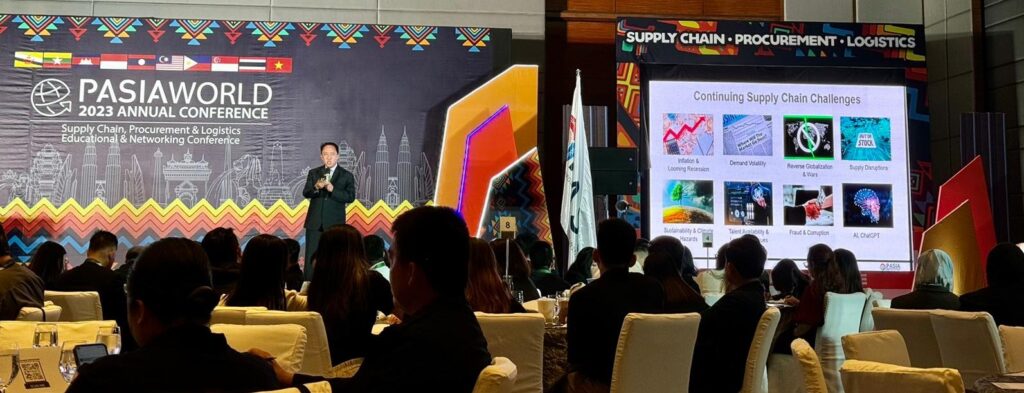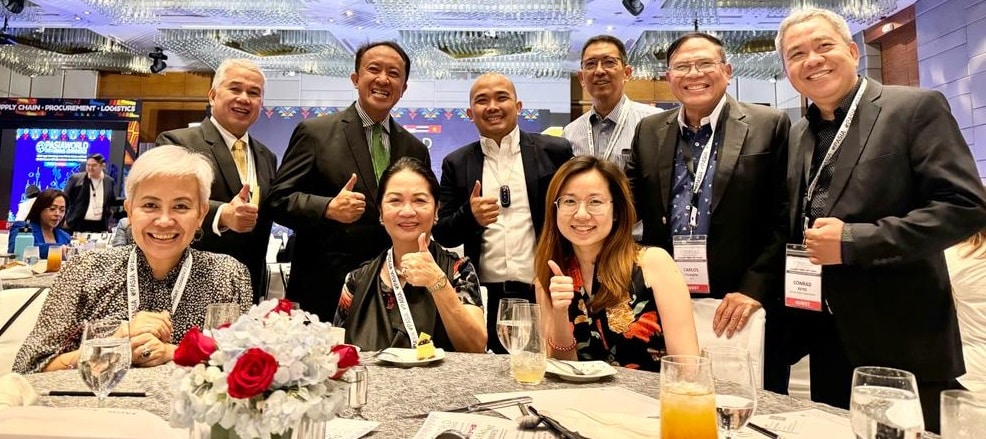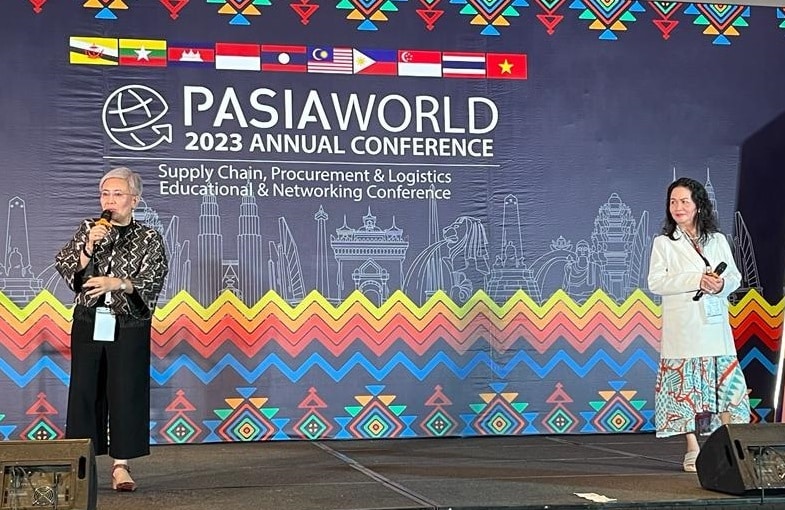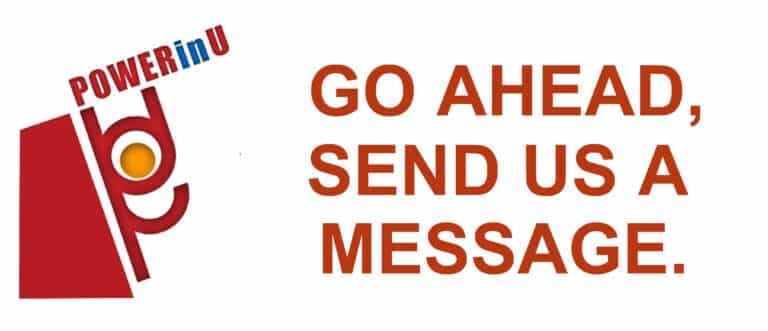By Thelma P. Meneses, Director, POWERinU Training & Coaching Philippines, Inc.
2023 PASIAWorld Conference achieved its 12th peat of successful years in advocating continuous excellence in the field of supply chain, procurement, and logistics. Hundreds of delegates attended and learned from exemplary line up of industry experts who selflessly shared their insights on latest trends, disruptive innovation practices, emerging change drivers as well as challenges that supply chains all over the world are facing. More importantly, the mere presence of such a huge delegation magnified the importance and valuable contribution that networking brings.
Salient points of discussion during the two-day session were:
- Volatility of Philippine business and its impact to supply chain
- Material scarcity
- Port congestions and delays of goods to arrive at the company’s doorstep.
- Digital transformation as an enabler to drive efficiency and effectiveness.
- Inflationary trends that directly affect prices of goods and services
- Real estate market that influences office rental rates, warehouse, and storage fees
- Sustainability programs moving from compliance to a force for good by companies.
- Geo-political tensions that influence macro- and microeconomics consumer behaviors
- Speed up Farm to Market through a strengthened Air, Water and Land Transportation Infrastructures
- Emerging human capital trends both cognitive and behavioral

Volatility of Philippine business and its impact to supply chain
With the pandemic that adversely impacted the supply chains all over the world, one cannot over-emphasize the importance of the company’s short-term financial health, including its capacity to have available cash to invest or reinvest. One speaker said that Supply chain directly contributes 70% to the company’s financial health. The company’s viability for long-term and sustainable growth requires future proofing its supply chain infrastructures. There is a need to be resilient, adaptable, and agile to immediately implement mitigating actions when required. A thorough and laser-focus strategies in forecasting, managing inventories, freight rates, as well as using technology to automate or strengthen analytics to accurately measure and/or predicts disruptions to for early risk management
Material scarcity
Due to continuous structural shifts in the market, labor shortages, demand for some products increased significantly leading to a huge gap between supply and demand. Such is the case for metals and mining, chemicals, automotives, semiconductors and technology chips. To mitigate such a shortage of supplies, there is a need to further strengthen supplier relationships through strategic collaboration and long-term business sustainability. Diversifying suppliers both domestic and international is also important. Lastly, investing in procurement tools that support data analysis and intelligent strategic choices.
Port congestions protocols resulting to adverse delays of goods to arrive at the company’s doorstep
The Association of Port Users in the Philippines advocates and engages the government in the pursuit of policies and regulations to address port issues in the Philippines including but
not limited to having a systematic way of planning to provide valuable port yard spaces as well as remedial work on operating procedures that are contributory to delays in the release of goods from the port yard. The group was happy to mention that the current government has been very open to listen to them and has conducted a regular dialogue with them.

Digital transformation -a culture enabler to drive efficiency and effectiveness
From amplifying customer experience, deepening big and small data analytics, to digitizing workflows and accurately tracking mechanisms to improve inventory and materials management as well as warehouse management and logistics, digital technology can optimize topline and service levels, too. The digital capability of supply chain will certainly ramp-up is reliability, efficiency, and effectiveness. While digital technology opens certain risks like cybersecurity and breach of confidentiality, further diligence and stronger governance are required to future -proof companies. It has been noted that driving technology within supply chain is vital, over-reliance or premature use of technology like AI without clarity of its use can also lead to adverse consequences. AI will not replace human capability. AI should complement and act as an enabler, not a substitute for the human workforce. On the other hand, there is a need to re-skill human capital to prepare workers to optimize the use of technology in the work area.
Inflation directly affects costs to procure products
The overall inflation rate in the Philippines is hovering around 6% and is forecasted to significantly go down to 3-4% next year. The positive outlook in the long term provides an opportunity for procurement to negotiate for lower prices of materials. While the forecast is bullish, it takes cautious optimism for supply chain professionals to anticipate risks by outlining different risk scenarios that increases supply chain confidence to lead to adverse or disruptive change in the business landscape. Since inflation rats directly affects prices of goods and services, supply chain needs to look at a bigger picture and find ways to bring down the cost of goods sold so that further increases in raw materials, labor, fuel, transportation are not passed on to consumers.
Real estate market that influences office rental rates, warehouse, and storage fees
Lobien Realty CEO presented very informative trends in real estate which includes vertical and horizontal residential and commercial activities per geographical location, rental rates, buyers, or sellers’ real estate market status. The dashboards provided valuable insights into available commercial spaces including but not limited to warehouses. When considering downsizing or expanding office spaces and warehouses, today is the best time to negotiate for long-term commitments at the lowest possible cost.

Sustainability programs moving from compliance to a force for good by companies
Common to most speakers is the importance of ESG in running a business. Positive and affirmative actions to reduce if not eliminate negative impact of practices around environment, social and governance are keys to sustainable growth of the business. There were suggested report writings on ESG, but it seems that report writing has not been standardized globally and certain criteria are either present in one country but not in another country. Maturity of some tracking and reporting is in its transition stage with government support and participation for good governance.
Geo-political tensions that influence macro- and microeconomics consumer behaviors
The escalating tension in the West Philippine Sea has been a major concern that directly challenges the stability of the country’s already volatile economy. The financial stability of a country is threatened by geo-political tensions. Uncertainties lower the risk appetite of financial institutions on cross-border credit as well as investment. The overall sentiment from the delegates was not too much on the financial instability but tended towards differing political views and the country’s issue on its fundamental right to sovereignty. As in any business economics discussion, the economic dashboards may look good but if the overall sentiments on the political, and social stability of the business climate drive unintended panic and speculations, consumer behaviors will be directly affected and certain demands and supply for goods and services will significantly disrupt supply chains operations.
Speed up Farm to Market through a strengthened Air, Water and Land Transportation Infrastructures
The good secretary of transportation, Honorable Jaime Bautista honored us with his presence and laid out his plan for the department’s mission to provide viable and efficient transportation systems. Aside from instituting policies and procedures which includes regulatory standards for safety operations, he spoke about the importance of bringing the goods from farm to market and thereby positively impact farmers welfare as well as lower cost of produce in the market thru efficient transportation systems. Agriculture in the Philippines continues to face the dilemma on the quality and ubiquity of local produce. Supply chain inefficiencies – like availability of cold chain infrastructure – prevent fresh products from being available in most markets. Efficient logistics and transportation will directly reduce if not eliminate the middleman and cost savings will most likely benefit the farmers and the consumers.

Emerging human capital trends both cognitive and behavioral
The emerging trends in supply chain:
- Behavioral – Need to be resilient, innovative, collaborative,
- Cognitive- harness the power of transformative technologies (IOT, Smartphones, Data Analytics, 5G, Mobile Computing, etc.) and
- Emerging work personas (hybrid, work from home, gig, crowdsourcing), necessitated a thorough review of the Supply Chain’s people strategy.
- There is a high turn-over of talent due to the changing and behavioral traits demanded by the business. Being persevering is no longer the norm. Moving from “getting by and surviving in crisis” is tiring and has its own limits especially if the crisis is prolonged and change is transformational and influenced by external factors. To emerge as winners, talents need to be resilient- the mind-set to overcome challenges by looking at those adversities not as barriers to success but as opportunities to seize while maintaining focus. As a result of “Work from Home” arrangements, social interactions that require face-to-face engagements have been significantly reduced. To cope, more and more communication platforms need to be discovered to keep everyone aligned and informed.
- The speed of rapid technology changes is too fast. Most employees seriously lag in coping with the new skill sets. The capability gaps, if not managed well, will adversely affect the supply chain’s productivity targets.
- There has never been a time in the past when investment in developing supply chain professionals has been at the forefront of discussions by any organization, Supply chain professionals worked their way up in a traditional way mostly staying in one company for more than 10 years. This led, in general, to self-limiting beliefs on what good looks like, Opportunity to grow and be exposed to cross-industries were not heavily practiced. Associations like PASIA are a good way to strengthen capability through professional accreditation, networking, and benchmarking.
- In the same manner, supply chain professionals need to transform their role in their organization from being a manager, to a strategic leader. Manager “Do Things right”. Leaders “Do the right Things”.
- A powerful tool to help leaders do the right thing, POWERinU’s solutions on “Navigating the Organization”.
Congratulations to Charlie Villaseñor and the Procurement and Supply Institute of Asia (PASIA) Team for the success of the event! We’re excited to continue our excellent work together.

